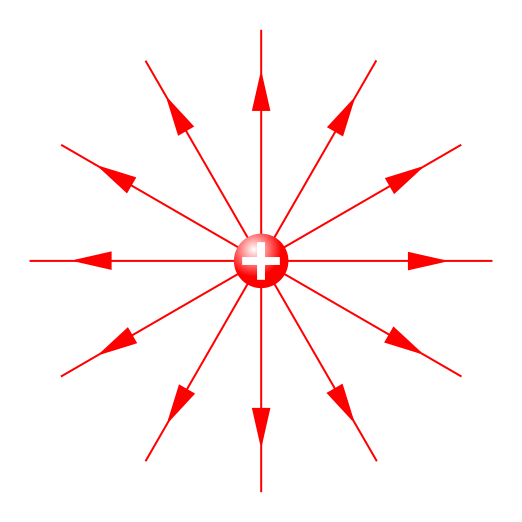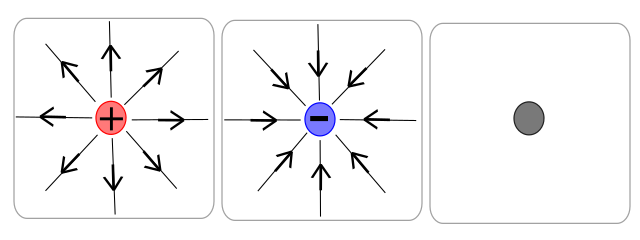OCR Specification focus:
‘State that electric fields are produced by charges and act on other charges.’
Electric fields describe how charges influence the space around them, enabling forces to act without physical contact. Understanding how charges create electric fields is essential for explaining electrical interactions across physics.
Electric Fields and Their Origin
Electric fields are a fundamental concept in electromagnetism, governing how charged particles interact across distances. The OCR specification emphasises that students must state that electric fields are produced by charges and act on other charges, anchoring this subsubtopic in the idea of charge-generated influence rather than direct mechanical contact.
When a particle possesses electric charge, it alters the region of space around it, creating what is known as an electric field. This concept allows physicists to describe electrical interactions in terms of fields rather than action-at-a-distance. Whenever another charge enters this region, it experiences a force determined by the field.

Electric field lines around a positive point charge radiate outward, showing the direction of force on a positive test charge and the diminishing field strength with distance. Source.
Electric Field: A region of space in which an electric charge experiences a force due to the presence of another charge.
This definition underpins the entirety of electric field theory in A-Level Physics, establishing the link between source charges and the forces felt by test charges. It also provides a framework for describing interactions without requiring the charges to be in physical contact, fitting neatly into the broader category of non-contact forces.
The Concept of Field Strength
The electric field strength, often symbolised by E, quantifies the effect of a source charge at a point in space. Although the detailed formula is covered in a later subsubtopic, it is essential here to establish the general meaning: field strength tells us how strong the field is and in what direction it acts.
Electric Field Strength: The force per unit positive charge experienced by a small test charge placed at a point in the field.
This definition highlights two important ideas:
The field is defined independently of the test charge, ensuring that the field remains a property of the source charge.
A positive test charge is the universal convention for defining field direction.
Electric field strength helps us quantify how a charge influences other charges placed in its vicinity, linking back directly to the specification requirement that fields act on other charges.
A key point for students to understand is that the field exists whether or not a second charge is present. The presence of the second charge simply reveals the field’s effects.
Direction of Electric Fields
Because electric fields involve vectors, direction is a crucial component of their description. For a positive source charge, the field radiates outwards; for a negative source charge, it points inwards. This directional behaviour reflects the attractive or repulsive nature of electrostatic forces.

This diagram compares field lines around positive, negative, and neutral particles. Outward and inward arrows show the force direction on a positive test charge, while the neutral particle’s lack of lines demonstrates the absence of an electric field. Source.
To interpret directions clearly, physicists use electric field lines, which represent the shape and behaviour of the field around charges. Although the detailed study of field lines belongs to a later subsubtopic, it is valuable here to establish their conceptual link to the idea of charge-generated influence.
Electric field lines always have the following properties:
They indicate the direction of the force on a positive test charge.
Their density shows the relative strength of the field.
They never cross, because a point cannot have more than one direction of field simultaneously.
These characteristics help visualise the otherwise invisible structure of the field.
How Charges Interact Through Fields
The statement that electric fields “act on other charges” highlights the operational role of fields in mediating forces. When a charge enters the electric field created by another charge, it experiences an electrostatic force determined by the field strength at that location.
This leads to several essential ideas:
Like charges repel, and this repulsion is experienced through the electric field.
Unlike charges attract, again mediated by the field rather than direct contact.
The magnitude of the force depends not only on the field strength but also on the size of the charge placed in the field.
These interactions form a cornerstone of classical electromagnetism. Even at the level of atomic structure, electric fields govern electron–proton interactions, meaning this A-Level topic connects deeply to chemistry, material science, and modern electronics.
Visualising Electric Influence
Understanding electric fields conceptually depends on recognising that every charge modifies the space around it. This modification can be described using various tools:
Field lines, showing direction and intensity.
Vectors, representing field strength at specific points.
Force diagrams, illustrating how a test charge responds.
Qualitative mapping, used in experiments with conductive paper or plotting compasses.
These visual tools help students move from abstract theoretical descriptions to practical understanding of how fields shape interactions.
Key Takeaways for This Subsubtopic
Electric fields originate from charges and extend outward into surrounding space.
These fields explain how charges exert forces without physical contact.
Field strength quantifies the effect of the field at any point.
Visual representations such as field lines support conceptual understanding.
A positive test charge is always used to define direction.
FAQ
An electric field exists even when no other charges are present to experience a force. It describes the influence created by a source charge in the surrounding space.
The force is only produced when another charge is placed in that field.
In simple terms:
Electric field: a property of space around a charge
Force: the measurable effect on a second charge
The convention simplifies diagrams and communication. By always using a hypothetical positive test charge, physicists maintain consistent definitions for direction.
If negative test charges were used, field directions would reverse, making comparison and interpretation more complicated.
Using a positive test charge is purely a convention; real particles used in experiments may be positive or negative.
A stationary charge creates a static electric field that depends only on distance from the charge.
A moving charge still produces an electric field, but the field shape is slightly distorted because changes in the charge’s position take time to propagate.
At A-Level, only the idea that both stationary and moving charges generate electric fields is relevant; magnetic effects from motion are treated separately.
The overall field still arises from the total charge, but its pattern depends on the distribution.
For symmetrical shapes such as spheres, the field outside behaves exactly as though all the charge were concentrated at a point at the centre.
For irregular shapes, the field varies from point to point, and lines may appear denser near areas with higher charge concentration.
Electric field lines show the direction of the electric field at each point in space.
If two lines crossed, it would imply two different directions of field at a single location.
Because a test charge cannot experience two different forces at the same point, crossing lines would contradict the physical meaning of a field.
Instead, field diagrams ensure only one unique direction is shown everywhere.
Practice Questions
Question 1 (2 marks)
State what is meant by an electric field and explain how the direction of an electric field is defined.
Question 1 (2 marks)
• Electric field is a region in which a charged particle experiences a force. (1)
• Direction of an electric field is the direction of the force on a positive test charge. (1)
Question 2 (5 marks)
A positively charged sphere is placed in space.
(a) Describe how this sphere creates an electric field and how another charged particle placed nearby is affected.
(b) Explain how electric field lines can be used to represent both the magnitude and direction of this field.
(c) Discuss why electric fields are described as non-contact forces.
Question 2 (5 marks)
(a)
• A charged sphere produces an electric field around it. (1)
• A nearby charge experiences a force due to this field. (1)
(b)
• Field lines show the direction of the electric field at different points. (1)
• The density or spacing of field lines represents the strength of the field. (1)
(c)
• Electric fields act without physical contact; the force occurs through the field in the space around the charge. (1)

